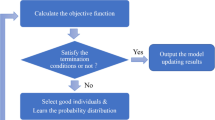Abstract
A novel finite element-based system identification procedure is proposed to detect defects in existing frame structures when excited by blast loadings. The procedure is a linear time-domain system identification technique where the structure is represented by finite elements and the input excitation is not required to identify the structure. It identifies stiffness parameter (EI/L) of all the elements and tracks the changes in them to locate the defect spots. The similar procedure can also be used to monitor health of structures just after natural events like strong earthquakes and high winds. With the help of several numerical examples, it is shown that the algorithm can identify defect-free and defective structures even in the presence of noise in the output response information. The accuracy of the method is much better than other methods currently available even when input excitation information was used for identification purpose. The method not only detects defective elements but also locate the defect spot more accurately within the defective element. The structures can be excited by single or multiple blast loadings and the defect can be relatively small and large. With the help of several examples, it is established that the proposed method can be used as a nondestructive defect evaluation procedure for the health assessment of existing structures.
Similar content being viewed by others
References
ANSYS version 5.7.2001. The Engineering Solutions Company
Caicedo J, Dyke S, Johnson E (2004) Natural excitation technique and eigensystem realization algorithm for phase I of the IASC-ASCE benchmark problem: Simulated data. J Eng Mechan 130(1):49–60
Clough R, Penzien J (1993) Dynamics of structures, 2nd edn. McGraw-Hill, Inc
Cook R, Malkus D, Plesha M (1989) Concepts and applications of finite element analysis, 3nd edn. John Wiley and Sons
Doebling S, Farrar C, Prime M, Shevitz D (1996) Damage identification and health monitoring of structural and mechanical systems from changes in their variation characteristics: a literature review. Report No. LA-13070-MS, Los Alamos National Laboratory, May 1996
Hoshiya M, Maruyama O (1987) Identification of running load and beam system. J Eng Mechan, ASCE 113(4):813–824
Housner G, Bergman L, Caughey T, Chassiakos A, Claus R, Masri S, Skelton R, Soong T, Spencer B, Yao J (1997) Structural control: past, present and future. J Eng Mechan ASCE 123(9):897–971
Katkhuda H, Martinez R, Haldar A (2003) Stiffness identification under uncertain blast loading. In: 4th International Symposium on Uncertainty Modeling and Analysis, University of Maryland, College Park, Maryland, pp 22–27
Koh C, See L, Balendra T (1991) Estimation of structural parameters in time domain: a substructure Approach. J. Earthquake Eng Struct Dynam 20(8):787–801
Koh C, See L, Balendra T (1995) Damage detection of buildings: numerical and experimental studies. J Struct Eng 121(8)
Lam H, Katafygiotis S, Mickleborough N (2004) Application of a statistical model updating approach on phase I of the IASC-ASCE structural health monitoring benchmark study. J Eng Mechan 130(1):33–48
Ling X (2000) Linear and nonlinear time domain system identification at element level for structural systems with unknown excitation. Report No. CEEM-001-101, Department of Civil Engineering and Engineering Mechanics, University Of Arizona, Tucson, Arizona
Ling X, Haldar A (2001) System identification using localized structural model. In: 8th International Conference on Structural Safety and Reliability (ICOSSAR’01) CD-ROM. June, 2001
Ling X, Haldar A (2004) Element level system identification with unknown input with rayleigh damping. J Eng Mechan, ASCE 130(8):877–885
Toki K, Sato T, Kiyono J (1989) Identification of structural parameters and input ground motion from response time histories. J Struct Eng/Earthquake Eng 6(2):413–421
Vo P (2003) Experimental study of the time domain damage identification. Technical report, Department of Civil Engineering and Engineering Mechanics, University of Arizona, Tucson, Arizona
Vo P, Haldar A (2004) Health assessment of beams - Experimental investigation. J Struct Eng 31(1):23–30
Wang D (1995) An element level time domain system identification technique with unknown input information. Report No. CEEM-95-106, University of Arizona, Tucson, Arizona
Wang D, Haldar A (1994) An element level SI with unknown input information. J Eng Mechan Div, ASCE 120(1):159–176
Yuen K, Au S, Beck J (2004) Two-stage structural health monitoring approach for phase I benchmark studies. J Eng Mechan 130(1):16–33
Author information
Authors and Affiliations
Corresponding author
Rights and permissions
About this article
Cite this article
Katkhuda, H., Haldar, A. Defect identification under uncertain blast loading. Optim Eng 7, 277–296 (2006). https://doi.org/10.1007/s11081-006-9972-9
Received:
Revised:
Issue Date:
DOI: https://doi.org/10.1007/s11081-006-9972-9




